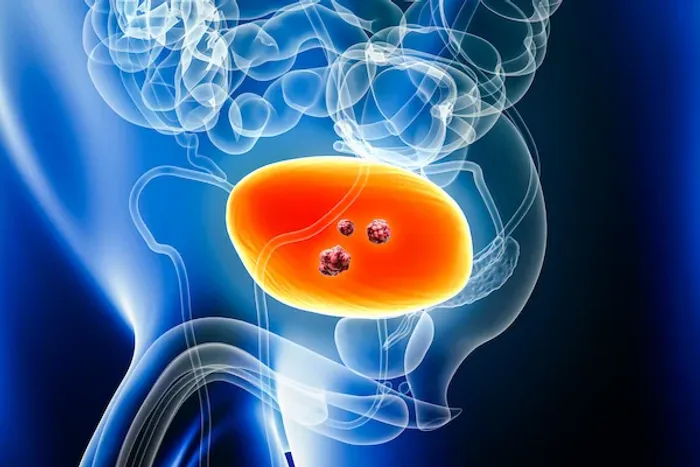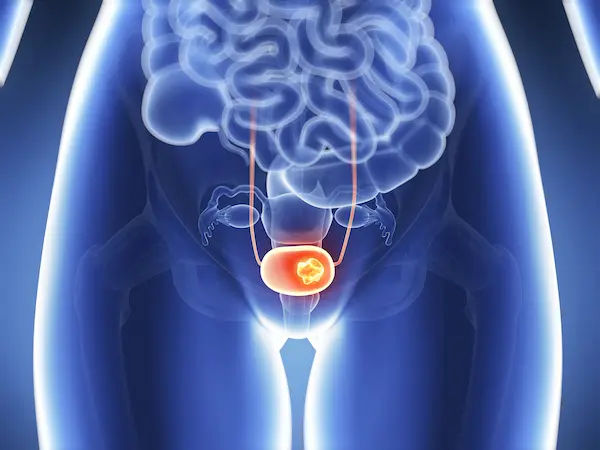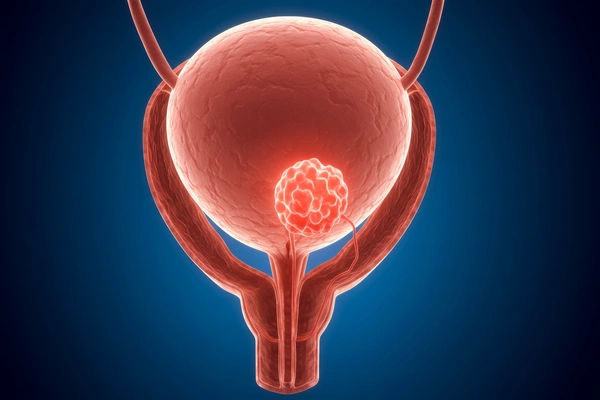What Leads To Signs Of Bladder Cancer: Understanding Types and Symptoms
Discover the signs of bladder cancer, its main types, risk factors, and symptoms such as blood in urine, urinary changes, and advanced stage indicators.

Written by Dr. Dhankecha Mayank Dineshbhai
Reviewed by Dr. Vasanthasree Nair MBBS
Last updated on 6th Oct, 2025

Introduction
Noticing a change in your bathroom habits or the appearance of your urine can be unsettling. While often linked to common issues like infections, certain signs shouldn't be ignored, as they could point to conditions like bladder cancer. This disease occurs when cells in the bladder lining grow uncontrollably, forming a tumour. Understanding what leads to these changes and the specific signs of bladder cancer is the first step towards proactive health. This article will demystify the connection between the causes, the different types of bladder cancer, and the symptoms they produce. We'll explore everything from the most common warning sign—blood in the urine—to more subtle changes, and explain how the cancer's type can influence its presentation. Our goal is to empower you with knowledge, so you can confidently discuss any concerns with a healthcare professional. If you experience persistent symptoms, consulting a doctor online with Apollo24|7 can provide timely guidance for further evaluation.
The Most Common Warning Sign: Blood in Urine (Haematuria)
Blood in urine, medically known as haematuria, is the most frequent and often the first sign of bladder cancer.
Gross Haematuria vs. Microscopic Haematuria
Gross haematuria means the blood is visible to the naked eye. You might see pink, red, or cola-coloured urine. Importantly, the amount of blood doesn't necessarily correlate with the severity of the condition. Even a small amount that causes a noticeable colour change warrants medical attention. Microscopic haematuria, on the other hand, is invisible. It's only detected through a urinalysis, a simple urine test done during a routine check-up. This is why regular health screenings are vital, as they can catch early signs of bladder cancer that would otherwise go unnoticed.
What Does Blood in Urine Look Like?
The appearance can provide clues. Blood that is bright red suggests recent bleeding, while a darker, brownish colour may indicate blood that has been in the bladder for a longer period. Sometimes, blood may not colour the entire stream of urine but only appear at the beginning or end. It's also possible to pass blood clots. Regardless of the specific appearance, any instance of visible blood in the urine is a strong indicator that you should consult a urologist for further evaluation.
Other Key Signs and Symptoms of Bladder Cancer
In addition to haematuria, bladder cancer can present with other urinary and systemic symptoms.
Irritative Urinary Symptoms
These occur because a tumour can irritate the delicate lining of the bladder. Key symptoms include:
Frequent urination: Feeling a strong, persistent need to urinate often, even when the bladder isn't full.
Painful urination (Dysuria): A burning sensation or pain during urination.
Urgency: A sudden, intense urge to urinate that is difficult to delay.
If these symptoms persist beyond a week or do not improve with initial treatment for a suspected infection, it's essential to investigate further.
Symptoms of Advanced Bladder Cancer
When cancer grows and spreads beyond the bladder, it can cause more systemic symptoms:
Lower back pain: Typically pain on one side of the back, indicating possible spread to the kidneys or surrounding tissues.
Bone pain: If the cancer metastasises to the bones.
Swelling in the feet.
Unexplained weight loss and fatigue.
The Main Types of Bladder Cancer
Bladder cancers are categorised by how the affected cells appear under a microscope.
Urothelial Carcinoma (Transitional Cell Carcinoma)
Accounting for over 90% of all bladder cancers, urothelial carcinoma begins in the urothelial cells that line the inside of the bladder. These cells are stretchy, allowing the bladder to expand and contract.
Non-Invasive vs. Invasive Urothelial Cancers: This is a key distinction. Non-invasive cancers are confined to the inner layer of the bladder lining (the mucosa) and have not grown into the deeper muscle wall. They are often treated successfully but have a high rate of recurrence. Invasive cancers have grown into the deeper muscle layer of the bladder wall, which makes them more serious and more likely to spread.
Squamous Cell Carcinoma
This type accounts for about 1–2% of bladder cancers in the United States but is more common in parts of the world where a parasitic infection called schistosomiasis is prevalent. It develops from thin, flat squamous cells that can form in the bladder after long-term irritation and inflammation.
Health topic carousel:
Doctor's speciality: Oncology
Text: Consult an Oncologist for the best advice
Adenocarcinoma
Making up about 1% of bladder cancers, adenocarcinoma begins in gland-forming cells. These cells can develop in the bladder after long-term inflammation and irritation.
Small Cell Carcinoma and Other Rare Types
Extremely rare, small cell carcinoma of the bladder starts in neuroendocrine cells. It is an aggressive cancer that often requires intensive treatment.
Can the Type of Cancer Influence the Symptoms?
The type of bladder cancer can affect how symptoms develop and present.
While all types primarily present with haematuria, the growth pattern of different cancers can influence symptom patterns. For instance, squamous cell carcinoma and adenocarcinoma are often associated with chronic irritation. Therefore, a patient might have a longer history of irritative symptoms like pain or frequent urination before haematuria becomes obvious. Urothelial carcinoma, especially the non-invasive papillary type, might cause intermittent haematuria with fewer irritative symptoms initially. However, it's impossible to self-diagnose the type based on symptoms alone; a proper medical diagnosis through tests like a cystoscopy is essential.
Major Risk Factors: What Leads to Bladder Cancer?
Understanding the key risk factors provides insight into what leads to bladder cancer.
Smoking; the No.1 Controllable Risk
Smoking is the single greatest risk factor for bladder cancer, responsible for about half of all cases. Harmful chemicals in tobacco smoke are absorbed into the bloodstream, filtered by the kidneys, and concentrated in the urine. These chemicals damage the lining of the bladder over time, significantly increasing the risk of cancerous changes.
Occupational Chemical Exposure
Certain occupations involving exposure to industrial chemicals pose a higher risk. Workers in the rubber, chemical, leather, textile, and printing industries may be exposed to carcinogens like aromatic amines and aniline dyes. Strict workplace safety measures are crucial for prevention.
Other Contributing Factors
Chronic Bladder Inflammation: Repeated urinary infections or long-term use of a urinary catheter can increase the risk of squamous cell carcinoma.
Age and Gender: Risk increases with age, and men are about three to four times more likely to develop bladder cancer than women.
Previous Cancer Treatment: Certain chemotherapy drugs (like cyclophosphamide) and radiation therapy to the pelvis increase future risk.
Family History: A small percentage of cases may have a genetic link.
When to See a Doctor: Taking Action on Symptoms
Knowing when to seek medical advice is vital for early detection and effective treatment.
Do not ignore blood in your urine, even if it happens only once and then clears up. Similarly, persistent urinary frequency, urgency, or pain should be evaluated. Early detection dramatically improves treatment outcomes. If you notice any of these signs, booking a physical visit to a urologist with Apollo24|7 is a proactive step. Diagnosis may involve imaging tests (like a CT scan) and a cystoscopy, where a thin tube with a camera is used to look inside the bladder. Apollo24|7 offers convenient home collection for necessary tests like urinalysis to begin the diagnostic process.
Conclusion
Recognising the signs of bladder cancer and understanding what leads to it empowers you to take charge of your health. While symptoms like blood in the urine can be alarming, they are your body's signal to seek medical advice. Remember, these signs are often caused by less serious conditions, but only a doctor can provide a definitive diagnosis. The different types of bladder cancer, from common urothelial carcinoma to rare forms, underscore the importance of a personalised approach to diagnosis and treatment. By being aware of the risk factors, particularly smoking, you can make informed lifestyle choices to lower your risk. If you have any concerns based on what you've read, don't hesitate to take action. Your health is worth it.
Frequently Asked Questions (FAQs)
Here are answers to common questions about bladder cancer, its signs, and treatment.
Can you have bladder cancer without blood in your urine?
Yes, it is possible, especially in the early stages. Some cancers may only cause irritative symptoms like frequent urination or pain. Microscopic blood may be present but not visible. However, the vast majority of cases do involve haematuria at some point.
What is the life expectancy for someone with bladder cancer?
Life expectancy varies greatly depending on the stage and type at diagnosis. Non-invasive bladder cancer has a very high 5-year survival rate (over 90%). Even for invasive cancers that haven't spread, the rate is around 70%. Early detection is the most critical factor for a positive outcome.
What are the first signs of bladder cancer in women?
The first signs are the same as in men: primarily blood in the urine (haematuria) and irritative voiding symptoms. However, women may initially attribute these symptoms to a urinary tract infection or post-menopausal changes, which can sometimes lead to a delay in diagnosis.
Is bladder cancer curable?
Many bladder cancers, especially those caught early while they are still non-invasive, are highly treatable and often curable. Even advanced cancers can be managed with a combination of treatments like surgery, chemotherapy, and immunotherapy.
How is bladder cancer typically diagnosed?
Diagnosis usually starts with a urinalysis to check for blood and infection. If needed, a cystoscopy is performed to visually examine the bladder. During this procedure, a doctor can take a tissue sample (biopsy) for definitive diagnosis. Imaging tests like a CT urogram may also be used.
Health topic carousel:
Doctor's speciality: Oncology
Text: Consult an Oncologist for the best advice
Consult Top Specialists for Personalised Tips

Dr. Sanchayan Mandal
Medical Oncologist
17 Years • MBBS, DrNB( MEDICAL ONCOLOGY), DNB (RADIOTHERAPY),ECMO. PDCR. ASCO
Kolkata
MCR SUPER SPECIALITY POLY CLINIC & PATHOLOGY, Kolkata

Dr. Rupam Manna
Radiation Specialist Oncologist
4 Years • MBBS MD(RADIO THERAPY)
Barasat
Diab-Eat-Ease, Barasat

Dr.sanchayan Mandal
Medical Oncologist
17 Years • MBBS, DrNB( MEDICAL ONCOLOGY), DNB (RADIOTHERAPY),ECMO. PDCR. ASCO
Kolkata
Dr. Sanchayan Mandal Oncology Clinic, Kolkata

Dr. Sanchayan Mandal
Medical Oncologist
17 Years • MBBS, DNB Raditherapy, DrNB Medical Oncology
East Midnapore
VIVEKANANDA SEBA SADAN, East Midnapore

Dr. Alakananda Choudhury
Radiation Specialist Oncologist
6 Years • MBBS, MD ( Radio Therapy )
Barasat
Diab-Eat-Ease, Barasat
Consult Top Specialists

Dr. Sanchayan Mandal
Medical Oncologist
17 Years • MBBS, DrNB( MEDICAL ONCOLOGY), DNB (RADIOTHERAPY),ECMO. PDCR. ASCO
Kolkata
MCR SUPER SPECIALITY POLY CLINIC & PATHOLOGY, Kolkata

Dr. Rupam Manna
Radiation Specialist Oncologist
4 Years • MBBS MD(RADIO THERAPY)
Barasat
Diab-Eat-Ease, Barasat

Dr.sanchayan Mandal
Medical Oncologist
17 Years • MBBS, DrNB( MEDICAL ONCOLOGY), DNB (RADIOTHERAPY),ECMO. PDCR. ASCO
Kolkata
Dr. Sanchayan Mandal Oncology Clinic, Kolkata

Dr. Sanchayan Mandal
Medical Oncologist
17 Years • MBBS, DNB Raditherapy, DrNB Medical Oncology
East Midnapore
VIVEKANANDA SEBA SADAN, East Midnapore

Dr. Alakananda Choudhury
Radiation Specialist Oncologist
6 Years • MBBS, MD ( Radio Therapy )
Barasat
Diab-Eat-Ease, Barasat




